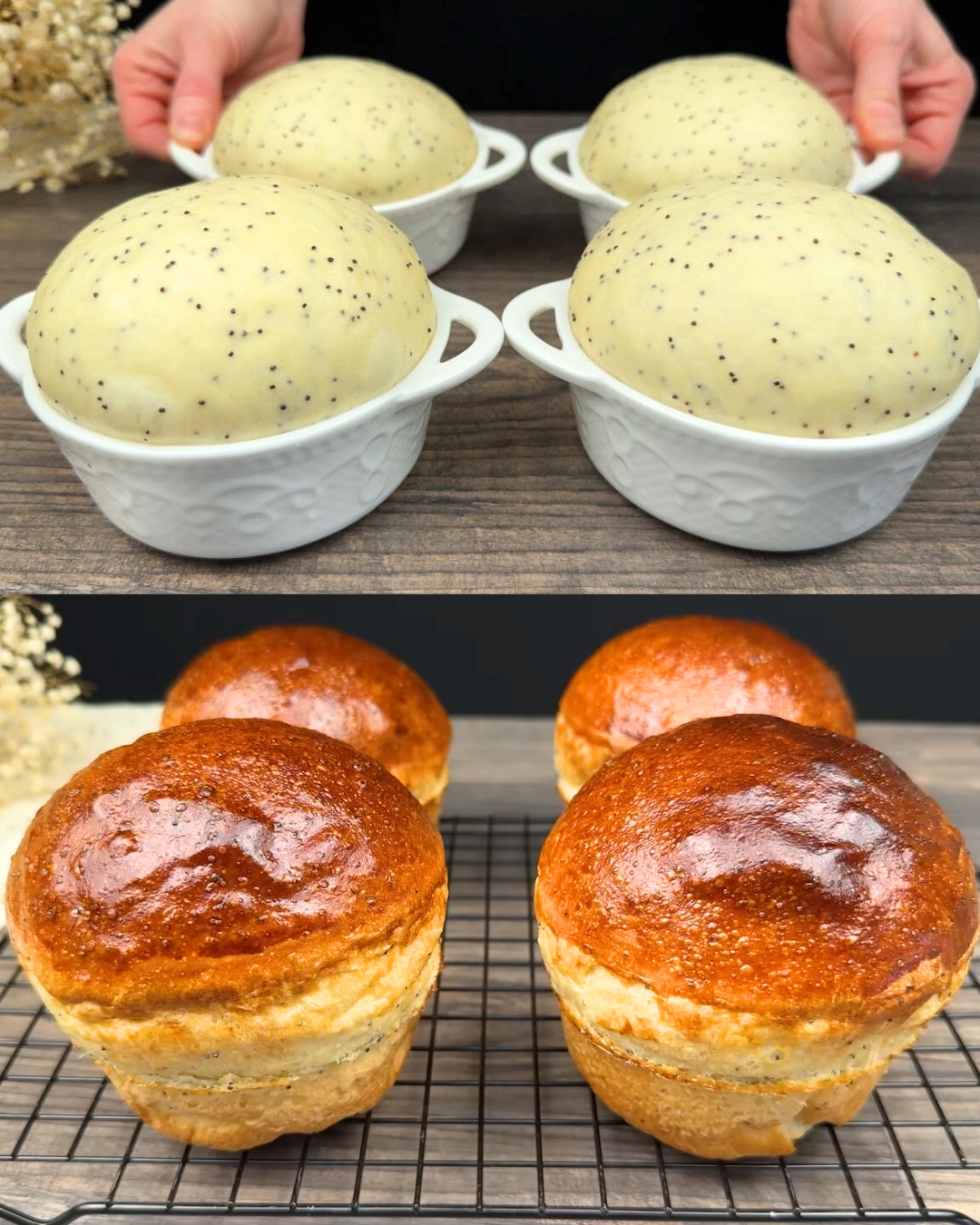There’s something special about recipes passed down through generations, and this one from Grandma is no exception. Simple yet ingenious, this recipe takes a basic dough and elevates it with a surprising secret ingredient: vinegar. While many might not think to add vinegar to their bread dough, it’s a trick that helps create a lighter, fluffier texture, and it’s something Grandma swears by. This recipe is perfect for those who love traditional baking but are always on the lookout for new tips and tricks. Whether you’re a seasoned baker or just getting started, this recipe is a must-try.
Ingredients:
- 475-500 grams (about 3 3/4 to 4 cups) of wheat flour
- 5 grams (about 1 1/2 teaspoons) of dry yeast
- 2 tablespoons of sugar
- 2 tablespoons of poppy seeds
- 1 teaspoon of baking soda
- 1 teaspoon of vinegar
- 1 egg
- 25 ml (about 2 tablespoons) of vegetable oil
- 0.5 teaspoon of salt
- 200 ml (about 3/4 cup + 1 tablespoon) of warm milk
Instructions:
- Prepare the Dough:
In a large mixing bowl, combine the dry yeast, sugar, and warm milk. Stir until the yeast is dissolved, and let the mixture sit for about 5-10 minutes, or until it becomes frothy. This step activates the yeast and is essential for a good rise. - Mix the Dry Ingredients:
In a separate bowl, sift together the wheat flour, baking soda, salt, and poppy seeds. Sifting helps to aerate the flour and ensures that the baking soda and salt are evenly distributed throughout the dough. - Add the Wet Ingredients:
Once the yeast mixture is ready, add the egg and vegetable oil to the bowl. Stir until well combined. Then, add the dry ingredients in batches, mixing continuously to form a soft dough. - Incorporate the Secret Ingredient:
Now comes Grandma’s secret touch: add the teaspoon of vinegar to the dough. Vinegar reacts with the baking soda to create additional lift in the dough, resulting in a lighter, airier texture. Knead the dough gently until the vinegar is fully incorporated. - Knead the Dough:
Turn the dough out onto a floured surface and knead for about 10 minutes, or until the dough is smooth and elastic. The dough should be soft but not sticky. If it’s too sticky, add a little more flour as needed. - Let It Rise:
Place the kneaded dough in a lightly greased bowl, cover it with a clean kitchen towel, and let it rise in a warm place for about 1-1.5 hours, or until it has doubled in size. - Shape and Second Rise:
Once the dough has risen, punch it down to release the air. Shape the dough into your desired form—whether it’s a loaf, rolls, or even braids—and place it on a baking sheet or in a greased loaf pan. Cover again and let it rise for another 30-45 minutes. - Bake:
Preheat your oven to 180°C (360°F). Once the dough has risen again, brush the top with a little milk or beaten egg for a shiny finish. Bake in the preheated oven for about 25-30 minutes, or until the bread is golden brown and sounds hollow when tapped on the bottom. - Cool and Serve:
Remove the bread from the oven and let it cool on a wire rack before slicing. This will help the bread retain its shape and prevent it from becoming soggy. Enjoy your homemade bread warm with butter, jam, or as a base for sandwiches.
Cooking Tips:
- Check the Yeast: Always make sure your yeast is fresh and active. If it doesn’t foam up during the first step, it might be expired or the milk may have been too hot.
- Kneading Time: Kneading is crucial for developing the gluten in the dough, which gives the bread its structure. Don’t rush this step.
- Use Warm Milk: The milk should be warm, not hot. Too hot, and it can kill the yeast; too cold, and the yeast won’t activate properly.
- Shaping the Dough: For a decorative touch, consider braiding the dough or sprinkling extra poppy seeds on top before baking.
Nutritional Benefits:
- Poppy Seeds: Poppy seeds are a good source of dietary fiber, calcium, and magnesium. They add a pleasant crunch and subtle nutty flavor to the bread.
- Whole Milk: The milk in the recipe provides essential nutrients such as calcium, vitamin D, and protein, contributing to the overall nutritional value of the bread.
- No Artificial Additives: Unlike many store-bought breads, this homemade version contains no preservatives or artificial ingredients, making it a healthier option.
Why You’ll Love This Recipe:
- Time-Tested Tradition: This recipe is a family treasure, passed down from Grandma, and is sure to bring a sense of nostalgia and warmth to your kitchen.
- Unique Flavor: The combination of poppy seeds and a hint of vinegar adds a unique flavor profile that you won’t find in typical bread recipes.
- Versatile: Whether you enjoy it as toast in the morning, as a sandwich for lunch, or as a side with dinner, this bread is versatile and delicious at any time of day.
- Satisfying Texture: The vinegar and yeast work together to create a light, fluffy texture that is incredibly satisfying.
Dietary Information:
- Vegetarian: This recipe is suitable for vegetarians as it contains no meat or animal-derived rennet.
- Can Be Made Vegan: To make this recipe vegan, you can substitute the egg with a flax or chia egg and use plant-based milk instead of dairy milk.
- No Artificial Ingredients: The bread is free from artificial preservatives and additives, making it a healthier choice compared to many commercial breads.
Why This Recipe Works:
The magic of this recipe lies in the balance of traditional bread-making techniques with a simple, yet effective secret ingredient—vinegar. The acid in the vinegar reacts with the baking soda, producing carbon dioxide gas that helps the dough rise, resulting in a lighter, fluffier bread. This, combined with the yeast, ensures that the bread has a good rise and structure. The poppy seeds add texture and a nutty flavor, while the warm milk and sugar feed the yeast, ensuring an excellent rise. Grandma’s recipe is a testament to the idea that sometimes, the simplest ingredients can create the most delightful results.
Conclusion:
Grandma’s secret recipe is more than just a bread recipe—it’s a piece of culinary heritage that brings together simple, wholesome ingredients to create something truly special. Whether you’re an experienced baker or new to the world of homemade bread, this recipe is sure to impress. The addition of vinegar might be unconventional, but it’s this little twist that makes all the difference. So next time you’re in the mood for some baking, why not give this recipe a try? You’ll be rewarded with a delicious, fluffy loaf that’s perfect for any occasion. Happy baking!

